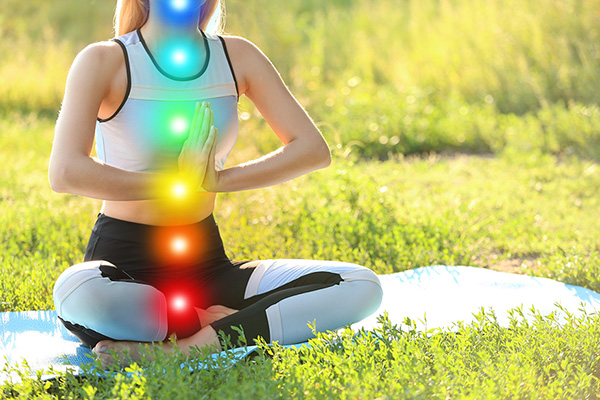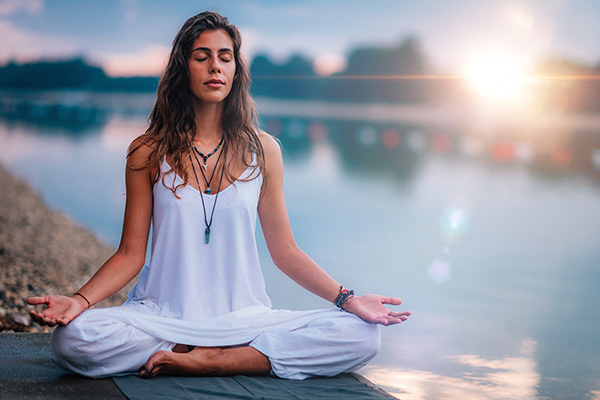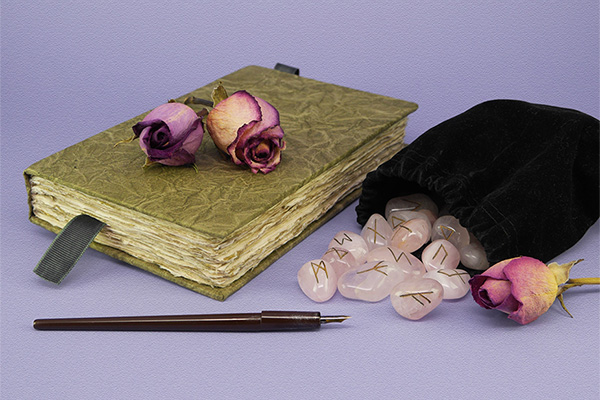breathing
Finding Silver Linings On The Dark Days
 The sky was dark this morning. Overcast, miserable, wet and windy. Not the best way to start any day.
The sky was dark this morning. Overcast, miserable, wet and windy. Not the best way to start any day.
To make matters worse, after several very busy days with readings, I had one of those rare “goose egg” days. Not a single client called me all day!
Halfway through my shift, I realized that my mind was starting to brew up all kinds of negative thoughts. Idle hands are indeed the devil’s workshop. Fortunately, I was able to nip it in the bud by the end of my shift. The last thing I needed in this miserable weather was to plunge myself into a pity party.
Instead, I gently coaxed myself back into a state of calm, centered inner peace and gratitude. After all, I have a lot to be thankful for in my life!
I also had to remind myself that I no longer have all my eggs in one basket. I have learned the hard way over the past few years to diversify my income, and I also have a nest egg in the bank for a rainy day.
Those of us who have been on a long and challenging journey to a better life realize that having a totally negative day is sometimes a necessary part of the process of self-improvement and greater fulfillment. If things were always easy and perfect, we would have no motivation to strive for anything better.
Spiritual Techniques For Emotional Closure
 Spirit has taught me, from a very young age, that gaining closure with a person (where necessary of course) is imperative so that we can move on with our lives in a positive way.
Spirit has taught me, from a very young age, that gaining closure with a person (where necessary of course) is imperative so that we can move on with our lives in a positive way.
After all, we cannot possibly embrace our future wholeheartedly without having effectively dealt with our past. There are three types of closure:
1. Natural closure that comes with the passage of time.
2. Direct closure that we may have with the person or persons involved and where love is concerned.
3. Third party closure when we meet someone else.
All well and good, you may be thinking, but it takes time to get that natural closure. Maybe your ex (or whoever) won’t give you direct closure and you don’t want to have to wait until you meet someone else in order to get it! But you do need a degree of closure now.
Well, spirit recognizes this and offers the two following solutions which may be of benefit to all those who need to gain closure on someone and find forgiveness, and start afresh in the shortest possible time:
How To Be More Present In Your Life
 We often hear the advice that ‘being present’ is an important spiritual practice to master on our journey through life. Being present with ourselves and in the moment. I like to think of it as being with yourself wherever you go and whatever you do. This is certainly true, but what exactly does it mean? And with all the busyness of life and keeping up with our daily responsibilities, how do you become more present in your life?
We often hear the advice that ‘being present’ is an important spiritual practice to master on our journey through life. Being present with ourselves and in the moment. I like to think of it as being with yourself wherever you go and whatever you do. This is certainly true, but what exactly does it mean? And with all the busyness of life and keeping up with our daily responsibilities, how do you become more present in your life?
Firstly, cultivating ‘presence’ requires time management and effective planning. It is important to organise the responsibilities of our lives in a manageable way. Otherwise, we find ourselves in a constant state of worry and stress, having to manage daily demands ‘on the fly’. And this is a sure way to lose our presence.
Planning ahead may seem like the opposite of being ‘in the moment’, but it is actually essential. When we are busy making plans for the coming week, thinking about what we need to prepare for and making decisions about how to organise our time and spend our energy, we don’t think much about the ‘present moment.’ But this is something we need to do in order to then be more present in our daily lives. It is key to cultivating presence.
How To Ground Your Energy
 ‘Grounding’ is a common term you are likely to encounter early in your spiritual awakening journey. If you are interested in energy work of any kind, grounding is a key technique to help you stay energetically balanced and enhance your metaphysical practice.
‘Grounding’ is a common term you are likely to encounter early in your spiritual awakening journey. If you are interested in energy work of any kind, grounding is a key technique to help you stay energetically balanced and enhance your metaphysical practice.
Essentially grounding is a type of meditation that is quick and very intentional. Through grounding we connect our own energy field or light body with the energy of the Earth. This balances our chakras by clearing out those energies that are no longer serve us. Connecting to the Earth’s energy in this way releases negative patterns, thoughts, emotions, and habits, to achieve a clearer, elevated state of consciousness.
To become more grounded, try this visualization exercise. Start by closing your eyes and focusing on your breathing. If you are used to meditation this will be very familiar, if not that is okay! Just be present with your breath and pay attention to your breathing as you inhale and exhale.
Count to three as you draw in your breath, and again as you exhale. Gradually slow the rhythm of your breathing down and just be present with the experience of the air moving in through your nose and into your chest. Feel your physical body around you as you breathe.
I like to focus on my heart chakra while I do this, but it is not necessary. I just find that as I breathe in and out, I like to feel the swell of air in my chest, as if is ‘hugging my heart.’
The Key Elements Of Spirituality
 One of the core principles of spirituality is the belief that we are all connected to something greater than ourselves. Whether we call this higher power God, Source, Spirit, the Universe, or the Divine, this belief is the fundamental tenet of all religions and spiritual traditions.
One of the core principles of spirituality is the belief that we are all connected to something greater than ourselves. Whether we call this higher power God, Source, Spirit, the Universe, or the Divine, this belief is the fundamental tenet of all religions and spiritual traditions.
By recognizing our connection to something greater than ourselves and the interconnectedness of all things, we find a sense of peace and purpose that transcends our individual concerns and uncertainties.
Another important aspect of spirituality is the concept of mindfulness. Mindfulness involves paying attention to the present moment, without judgment or distraction.
By practicing mindfulness, we become more aware of our thoughts, feelings, and physical sensations, and learn to cultivate a greater sense of inner peace and calm. Mindfulness can take many forms, from simple breathing exercises to more elaborate meditation practices.
Gratitude is another key component of a truly spiritual lifestyle. By cultivating a sense of appreciation for the gifts and blessings in our lives, we shift our focus away from self-limiting fear, negativity, lack consciousness and a scarcity mentality towards the love, hope, benevolence and abundance that surrounds us.
Whether we are grateful for our health, our relationships, or simply the beauty of the natural world, expressing gratitude can help us feel more content and fulfilled.
Inspire Your Journaling With The Runes
 Journaling is a powerful practice for self-discovery and personal growth. It allows one to reflect on your thoughts and emotions, gain clarity, and connect with your inner wisdom. Sometimes finding the necessary inspiration for a journal entry can however be difficult. A wonderful way to enhance your journaling practice is by incorporating runes. The runes are an ancient Germanic alphabet used for writing, divination, and magic. Each rune features a unique symbol representing different aspects of life and the natural world.
Journaling is a powerful practice for self-discovery and personal growth. It allows one to reflect on your thoughts and emotions, gain clarity, and connect with your inner wisdom. Sometimes finding the necessary inspiration for a journal entry can however be difficult. A wonderful way to enhance your journaling practice is by incorporating runes. The runes are an ancient Germanic alphabet used for writing, divination, and magic. Each rune features a unique symbol representing different aspects of life and the natural world.
The use of runes as a divination tool dates back to the Viking Age (793–1066 CE) and has been practiced by many cultures throughout history. Today, runes are often used as a tool for self-discovery, personal growth, and spiritual practice.
Using the runes to inspire journaling is a simple and effective way to take your spiritual practice to the next level. Here are some steps to get you started.
1. Choose a set of runes that resonates with you. You can order a rune set online, purchase it at your local metaphysical shop, or even make your own. Each set should include 24 runes, plus one blank rune that represents the unknown or unexpected.
2. Set an intention for your rune journaling practice. Before you begin, relax, take a few deep breaths, and then set a clear intention for what you wish to gain from today’s journaling session. It might be clarity, insight, healing, or guidance on a specific issue.
Healing From A Relationship Break-Up
 Breaking up with someone can be one of the most difficult experiences in life, especially when it is a long and deeply meaningful relationship. It can feel impossible to see any future without that person and very difficult to move on and find joy in life again.
Breaking up with someone can be one of the most difficult experiences in life, especially when it is a long and deeply meaningful relationship. It can feel impossible to see any future without that person and very difficult to move on and find joy in life again.
I find many of my clients do not realize that dealing with a break-up or divorce is very similar to processing the bereavement and grief associated with the passing of a loved one. It is often accompanied by agonizing sorrow, intense feelings of despair, and an all-encompassing sense of loss and confusion.
According to clinical psychologist Dr. Tricia Wolanin it is actually “the death of a relationship, hopes and dreams for the future. The person we are losing was a big part of our world and therefore has taken up so much of our mental and heart space.”
It is however possible to recover, heal and move on after any breakup or divorce. In my work I have found the following strategies to be helpful for clients who go through this kind of life challenge.
Avoid Major Life Decisions
It is usually not a good idea to make any important life decisions if you are working through the aftermath of a breakup. This includes changing your job or career, relocating, or making other drastic changes to your life. It is vital to take some time to heal and reflect on the situation before making hasty life-changing decisions that you may later live to regret.